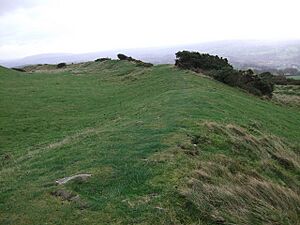Moel y Gaer, Rhosesmor facts for kids
Moel y Gaer is a special place in Wales. Its name means "bald hill of the fortress" in Welsh. This ancient site is an Iron Age hillfort. It sits on top of a hill near Rhosesmor village in Flintshire. From here, you can see the Dee Estuary. This hillfort is very well-preserved. Digs in the 1970s found old wooden defenses. They also found different building stages inside the fort's walls.
Contents
What is Moel y Gaer?
Moel y Gaer is an ancient hillfort. It was built a long time ago by people in the Iron Age. A hillfort is a type of fort built on a hill. People used them for protection. They often had strong walls and ditches. Moel y Gaer is a great example of these old forts. It shows us how people lived and protected themselves.
When was Moel y Gaer used?
People lived at Moel y Gaer for a very long time. It was used from the Neolithic period. This was a time even before the Iron Age. People might have lived there on and off. They stopped using it before the Romans came to Britain. This means it was used for thousands of years.
What did archaeologists find?
Archaeologists are like history detectives. They dig up old sites to learn about the past. At Moel y Gaer, they found signs of early homes. These were long wooden houses from the Neolithic period. They are some of the oldest homes found in this area.
Later, around 700 BC, people started building defenses. First, they put up a wooden fence called a palisade. This fence went around their homes. These homes were round wooden huts. Over time, they made the defenses stronger. They built a wall of stone and earth. They also dug a ditch around the fort.
Discovering the Hillfort's Secrets
Most of the digging at Moel y Gaer happened in the early 1970s. This was before a large water tank was built on the hill. The tank was planned for 1979. It would cover part of the old fort. So, archaeologists worked quickly to learn as much as they could.
How did the fort change over time?
The digs showed that the fort changed a lot. There were three main building stages. Each stage had different types of homes.
Phase One: Early Round Huts
In the first stage, people built round huts. Archaeologists found circles of postholes. These are holes where wooden posts once stood. The posts held up the walls of the huts. The doorways of these huts had extra posts. This might have made them stronger.
Phase Two: New Huts and Rectangular Buildings
The second stage brought new ways of building. The round huts were different. Their roofs rested on walls made of packed stakes. This was a new building method. Also, new types of buildings appeared. These were rectangular. They had four big posts at their corners. These buildings were set up in neat rows. This suggests a planned layout for the village.
Phase Three: A Different Layout
After a break, people came back to live at Moel y Gaer. This was the third stage. They built rectangular homes again. But this time, they used long wooden beams for the walls. These homes were not in neat rows. They were scattered around the site. This shows a less formal way of living.


